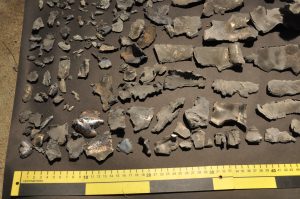Cold Detonation Physics (CDP) is a new field of detonation mechanics that is based on the rapid reduction of carbon dioxide back to carbon. By comparison, conventional explosives operate on the principle of rapid combustion of carbon to carbon dioxide facilitated through a nitrogen-based oxygen source.
According to ‘Rock Fracture and Blasting: Theory and Applications, 2016’ “Measurements in blasting show that explosives provide fracture energy (0.1 – 6.0%), seismic energy (0.6 – 12%), and kinetic energy (3.3 – 39%) out of the total available explosive energy. The sum of these three energies varies from 8.5 to 40%, meaning 60 – 91.5% of the energy in a traditional blasting product is lost to heating, internal fracture, borehole expansion, escaping gases, fragment rotation, and other uncounted energies.”
According to Chemistry/Trace/Explosives by S. Doyle, in Encyclopedia of Forensic Sciences (Second Edition), 2013, “The energy efficiency of ANFO ranges from 50 to 70%, depending on cartridge diameter (larger gives greater efficiency). The ratio of the amount of energy actually released by an explosive to the calculated thermochemical energy is defined as the energy efficiency of the explosive.” This implies that of the 50 to 70% available energy, only 8.5 to 40% will perform work breaking rock, which is 4.25 to 28% of the total amount available.
CDP detonates to produce about 50% solids and 50% gas, which work together to deliver a higher than typical percentage of available explosive energy to perform work on the surrounding environment. Solid byproduct particles, impacting the inner borehole wall at detonation velocities, impart their energy more efficiently than a compressible gas.

High gas-producing traditional explosives have low energy efficiency at breaking rock and their detonation velocities can range from 2,500 m/s to over 6,000 m/s. With traditional explosives, substantial energy loss while blasting is unavoidable do to how they all detonate to produce mainly high temperature gases and virtually no solids at all.
CDP, however, does not actually produce gas. Instead, additional dry ice is added to the formulation for the purpose of being vaporized to produce pressure, which increases Velocity of Detonation, or VOD. VOD is measured by using probes that respond to the detonation wave as the material is in the process of detonation. If the VOD is higher than the speed of sound in the same material, detonation has occurred.
When CDP is detonated in a steel pipe to produce CDP abrasives, the pipe is totally destroyed and becomes a pile of shrapnel. The size and range of sizes of pipe shrapnel can be used to compare explosive performance. This video examines CDP VOD and pipe shrapnel produced from detonation.